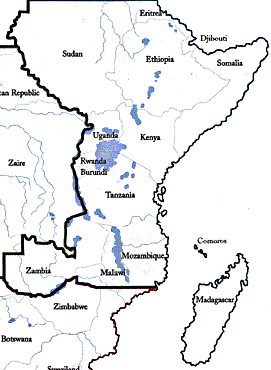

EASTERN AFRICA
is geographically complex, ranging from the mountains of central Ethiopia to coastal plains and offshore islands. Farther inland are the great lakes of Africa, forests, and the Rift Valley, the cradle of humankind. Tools and fossil remains of the earliest humans have been found in an area that extends from the Olduvai Gorge in Tanzania and northward into Ethiopia.

<--- Memorial Post, Southern Mijikenda, Kenya
Collection of Roy and Sophia Sieber
Much more recently, eastern Africa has, like much of the continent, witnessed migrations and population displacements, which have created an area that is culturally and linguistically complex. T he incursion of Bantu peoples from the west displaced earlier hunter-gatherers.Eastern Christianity came to Ethiopia from a base in northern Egypt in the fourth century. Later, through trade and holy wars, Islam conquered much of the Mediterranean littoral, the Nile Valley, and the eastern coastal regions. Like the Christians, the M uslims brought literacy in the combined names of religion and mercantilism.
Still later, explorers, traders, and missionaries-first from Portugal and later from most other European countries-introduced Roman Catholicism and a variety of Protestant faiths to the coast.

Snuff Container, Kambe,
Wood and Ivory
Collection of Marc and Denyse Ginzberg
In 1884 at the Berlin Conference, Africa was partitioned among the European powers. The colonial period ended in the mid-twentieth century with the independence of most states not only in eastern Africa but throughout the continent.
This complex past is reflected in the arts of eastern Africa. These include the manuscripts and processional crosses of Ethiopian Christianity, as well as objects associated with Islam.
Farther south, along the coast, are architectural forms influenced by Arabic sources via the Indian Ocean trade and adapted for local uses; the unique blend of art forms and ideas that resulted is called Swahili. In southern Sudan, in Kenya, a nd as far south as the island of Madagascar are found memorial statues dedicated to the distinguished dead, ranging in style from extremely abstract renditions of the human body to detailed tomb sculptures.
Skirt, Iraqw, Tanzania, early 20th century (?),
Dressed animal skin, glass beads, sinew thread, and metal bells,
170 x 170 cm. Commonwealth Institute, London.Many works relate to changes of status, from initiation into adulthood for young women and men to induction into leadership roles.
Each group has its own objects and system of symbols, though some have been shared among several groups .Within each group, individuals may announce or underscore their status by displaying personal objects, furniture, clothing, or body arts.
<- Back to the Main Index Page
<- To the Clickable Map of Africa ->
<-To Programs and Events in Conjunction with this Exhibition ->